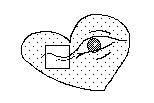Monthly Poem and Pictograph in EL (October 2004) [the wrinkles (笑いジワ)] by Mamico

 .
.  .
.  .
. 
 .
. 

This is an EL (Earth Language)
experimental page to enjoy
the image of a haiku/short poem originally in
English/Japanese.
When you can't see the Japanese
parts, please don't mind and just skip those parts.
地球語の文字や文字絵を用いて詩的表現や翻訳を試みる実験のページです。
The haiku in
"English Haiku" sounded supple and fresh making me feel like a young
wife. Although later I knew she, Mamico, was single in her mail giving
me her permission to use her haiku.
Most of her haiku don't have seasonable words, breaking a common rule
of traditional haiku, catching a moment of her feeling once a day.
Instead of seasons of a year, I feel some season in a life span through
her haiku.
This Japanese verse, Mamico feels full of joy to read 'the wrinkles.'
Contrary, the wrinkles in front of me tells more various history, because
now I'm in autumnal season in my life. I enjoyed the gap.
とてもすなおで初々しい俳句のサイト
English Haiku (9月)を見つけました。結婚したてを思い浮かべながら読みましたが、快く俳句の使用許可をくださったメールによると、
作者Mamicoさんは独身なんだそうです。
彼女は、季節を詠みこむかわりに、心の動きの一瞬を毎日一句切りとっています。
季語はないけれど、「人生の季節感」を思わず感じました。この日本語の句からは、
「君のシワ」を読むのが楽しくてたまらない若さが溢れています。
一方、人生の秋に達したわたしの「君のシワ」は、いろんな歴史を同時に語りかけます。読み手によってイメージ差ができるのがおもしろい。
the wrinkles

The English version by Mamico:
I measure your
mood by the wrinkles
around your eyes
The Japanese version is also by Mamico:
笑いジワ君の機嫌のバロメーター
The EL translation by Yoshiko:










The symbols in the pictograph and the EL translation:
(Each bases of symbols and an empty space has a frame here,
but you
don't need it in actual writings.
基礎記号と空白に枠を表示していますが、実際には必要ありません。
地球語では、基礎記号を重ね合わせて多数の文字を構成します
。)
 : heart, feeling 心
: heart, feeling 心
 {
{ ,
, sense}(eye-shape): eye(s) 目
sense}(eye-shape): eye(s) 目
 {
{ surface,
surface, waved}: wrincle(s)/rumpled
しわ
waved}: wrincle(s)/rumpled
しわ
EL is not so fussy about distinguishing a noun if it's single/plural.
If you want to make  and
and  clear as plural, you can
compound
clear as plural, you can
compound  (plural) on top of
each character.
(plural) on top of
each character.
日本語同様、地球語でも単・複数の区別を常時する必要はありません。どうしても区別したい場合には複数を意味する記号を重ねます。
 {
{ heart,
heart,  condition}: emotional
condition 心の状態
condition}: emotional
condition 心の状態
 : d-verb symbol to form a verb
meaning that (the subject of its sentence) become the following condition.
: d-verb symbol to form a verb
meaning that (the subject of its sentence) become the following condition.
This sentence having a verb on the head is not a command, not like
English. Imperative/interrogative sentence in EL forms in the different
way. When anybody can guess the subject as the talker or a commonly recognizable
thing, EL doesn't need to show the subject of a sentence; and this is the
example case.
これは、これに続く文字の状態に主語がなるという意味で動詞を構成するための動詞符。命令・疑問文などは、文頭の形で見分けます。動詞が頭にあり、述語だけの文章でも命令ではありません。
 {
{ sense,
sense,  recognition}: perception, 知覚
recognition}: perception, 知覚

 : sense (as v.), read 知覚・認識する
: sense (as v.), read 知覚・認識する
 : the grammatical symbol to show that the following character or
phrase is an accusative case of a d-verb; a target of the action of the
subject of the sentence.
: the grammatical symbol to show that the following character or
phrase is an accusative case of a d-verb; a target of the action of the
subject of the sentence.
続く文字がD動詞の対象になる格であることを示す文法記号
 {
{ front,
front, pronoun-maker}: you, your ; ( this hand-sign points front by the thumb
in front of the chest) あなた
pronoun-maker}: you, your ; ( this hand-sign points front by the thumb
in front of the chest) あなた
 {
{ preposition,
preposition,  way}: through ~を通って/通じて(の)
way}: through ~を通って/通じて(の)
 {
{ preposition,
preposition, circumference}:
around ~のまわりの(に)
circumference}:
around ~のまわりの(に)
to the top






 : heart, feeling 心
: heart, feeling 心 {
{ waved}: wrincle(s)/rumpled
しわ
waved}: wrincle(s)/rumpled
しわ clear as plural, you can
compound
clear as plural, you can
compound  (plural) on top of
each character.
(plural) on top of
each character.  {
{ heart,
heart,  condition}: emotional
condition 心の状態
condition}: emotional
condition 心の状態 : d-verb symbol to form a verb
meaning that (the subject of its sentence) become the following condition.
: d-verb symbol to form a verb
meaning that (the subject of its sentence) become the following condition. sense,
sense,  recognition}: perception, 知覚
recognition}: perception, 知覚
 front,
front, {
{ preposition,
preposition,  way}: through ~を通って/通じて(の)
way}: through ~を通って/通じて(の) preposition,
preposition, circumference}:
around ~のまわりの(に)
circumference}:
around ~のまわりの(に)